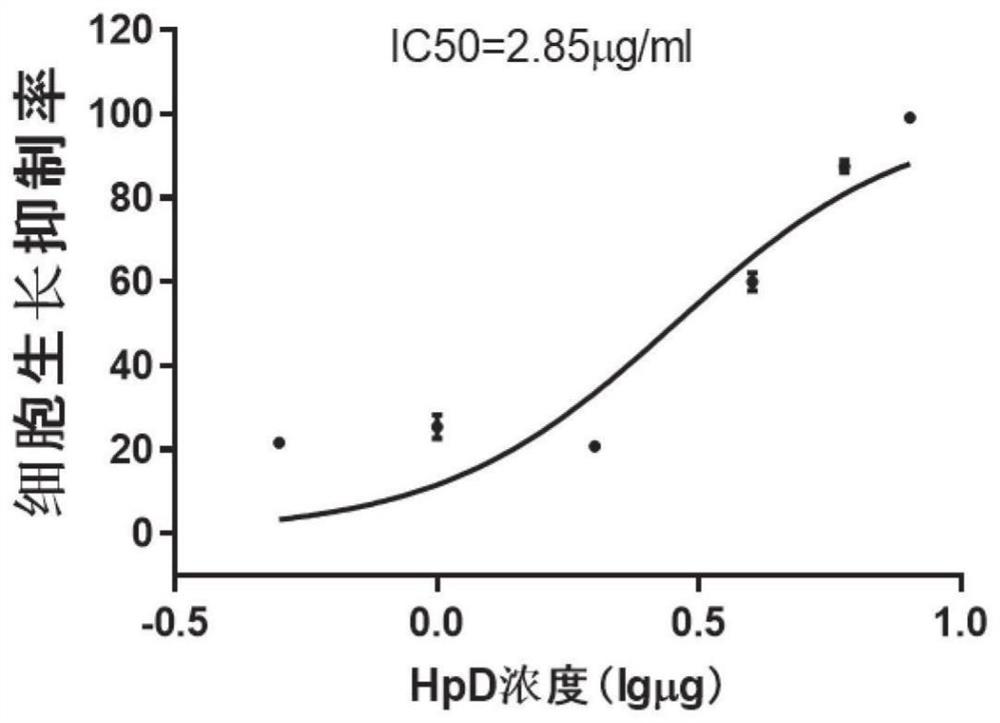Application of chlorin e6 trimeglumine salt in photodynamic therapy of cervical cancer and precancerous lesions
A technology of chlorin and meglumine salt is applied in the application field of chlorin e6 trimeglumine salt in photodynamic therapy of cervical cancer and precancerous lesions, and can solve the problem of untreated cervical cancer and cervical cancer. Pre-lesion, no reports and other problems, to achieve the effect of high light absorption intensity and fast metabolic clearance
- Summary
- Abstract
- Description
- Claims
- Application Information
AI Technical Summary
Problems solved by technology
Method used
Image
Examples
Embodiment 1
[0039] In this experiment, cervical cancer HeLa cells were selected as the experimental cell lines, which were purchased from the National Biomedical Experimental Resource Cell Bank. Take well-grown logarithmic growth phase cells, and the cell concentration is 1×10 5 cells / mL, seeded in a 12-well plate, 1 mL per well, and cultured in an incubator. Adjust the concentration of KAE to 0.25, 0.5, 1, 1.5, 2, and 4 μM with DMEM medium containing 10% serum, wash the cell seed plate with PBS after 36 hours of culture, and add 1 mL of the medium containing different concentrations of KAE to each experimental group , add 1mL culture medium to the control group, set 3 duplicate holes for each concentration, put the cell culture plate into the incubator and incubate for 4h, wash it with PBS, and then irradiate it with a 660nm laser with a power density of 10mW / cm 2, the irradiation time is 1000s. After the laser irradiation was completed, the cell culture plate was placed in an incubato...
Embodiment 2
[0042] In this experiment, cervical cancer HeLa cells were selected as the experimental cell lines, which were purchased from the National Biomedical Experimental Resource Cell Bank. Take well-grown logarithmic growth phase cells, and the cell concentration is 1×10 5 cells / mL, seeded in a 12-well plate, 1 mL per well, and cultured in an incubator. The concentration of HpD was adjusted to 0.5, 1, 2, 4, 6, and 8 μg / mL with DMEM medium containing 10% serum, and the cells were washed with PBS after culturing for 36 hours. Each experimental group was added with the culture medium containing different concentrations of HpD Add 1mL culture medium to the control group, and add 1mL culture medium to the control group. Three replicate wells are set up for each concentration. After the cell culture plate is placed in the incubator for 4 hours, it is washed with PBS, and then irradiated with a 660nm laser with a power density of 10mW / cm2. The irradiation time is 1000s. After the laser i...
Embodiment 3
[0045] Select 25 8-week-old Babl / c mice to prepare a suspension of HeLa cells with a cell concentration of 1×10 7 / ml, inject 100 μl of cell suspension intradermally on the back of the mouse, and when the tumor grows to about 8 mm, select 18 mice with relatively consistent tumor size and inject KAE (20 mg / kg) into the tail vein, respectively. Three mice were randomly selected at each time point of 2h, 4h, 8h, 12h, 24h and 48h, and the mice were killed by cervical dislocation, and the tumor, skin, liver, lung, kidney (2) and spleen were removed immediately, and then Weigh and record the weight of each tissue and organ, then soak the tissue with the same weight in liquid nitrogen, grind the tissue after it is completely frozen and brittle, collect the powder in a centrifuge tube, add 5ml of enzyme-free water to the centrifuge tube and mix well , stirring, and centrifugation to collect the supernatant, and take 2ml of the supernatant to detect the fluorescence spectrum of each sa...
PUM
 Login to View More
Login to View More Abstract
Description
Claims
Application Information
 Login to View More
Login to View More - R&D
- Intellectual Property
- Life Sciences
- Materials
- Tech Scout
- Unparalleled Data Quality
- Higher Quality Content
- 60% Fewer Hallucinations
Browse by: Latest US Patents, China's latest patents, Technical Efficacy Thesaurus, Application Domain, Technology Topic, Popular Technical Reports.
© 2025 PatSnap. All rights reserved.Legal|Privacy policy|Modern Slavery Act Transparency Statement|Sitemap|About US| Contact US: help@patsnap.com



